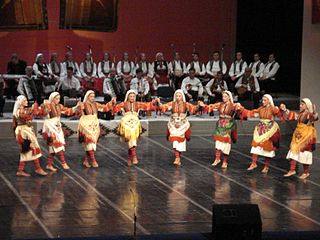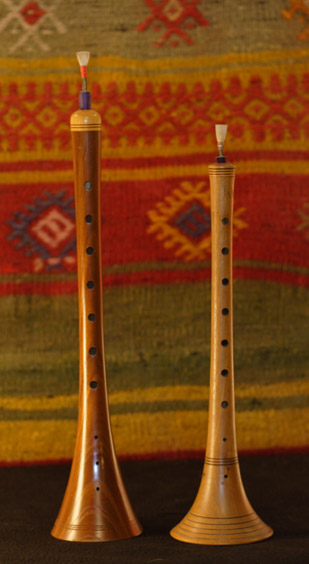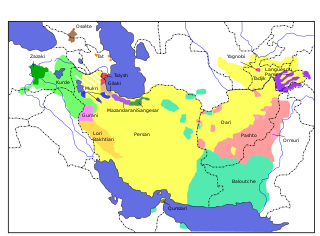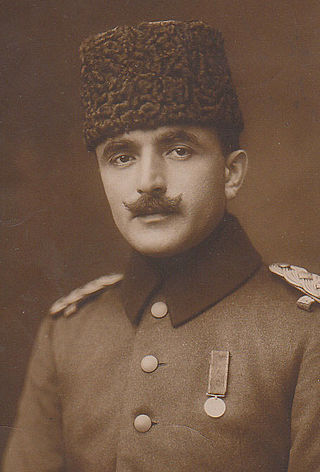Related Research Articles

Demographic features of the population of Turkey include population density, ethnicity, education level, health of the populace, economic status, religious affiliations and other aspects of the population.

The Kurds are an Iranian ethnic group in the Middle East. They have historically inhabited the mountainous areas to the south of Lake Van and Lake Urmia, a geographical area collectively referred to as Kurdistan. Most Kurds speak Northern Kurdish Kurmanji Kurdish (Kurmanji) and Central Kurdish (Sorani).

Hora, also known as horo and oro, is a type of circle dance originating in Aromanian and Romanian communities, especially in Romania and Moldova. It is also found in other South East European countries and culturally adopted by ethnic minorities such as the Ashkenazi Jews and the Roma.

Kochari is a folk dance originating in the Armenian Highlands. It is performed today by Armenians, while variants are performed by Assyrians, Azerbaijanis, Kurds, and Pontic Greeks. It is a form of circle dance.

The davul, dhol, tapan, atabal or tabl is a large double-headed drum that is played with mallets. It has many names depending on the country and region. These drums are commonly used in the music of the Middle East and the Balkans. These drums have both a deep bass sound and a thin treble sound due to their construction and playing style, where different heads and sticks are used to produce different sounds on the same drum.

Turkish folk music is the traditional music of Turkish people living in Turkey influenced by the cultures of Anatolia and former territories in Europe and Asia. Its unique structure includes regional differences under one umbrella. It includes popular music from the Ottoman Empire era. After the foundation of the Turkish Republic in 1923, Turkish President Mustafa Kemal Atatürk ordered a wide-scale classification and archiving of samples of Turkish folk music from around the country, which, from 1924 to 1953 collected more than 10,000 folk songs. Traditional folk music was combined with Western harmony and musical notation to create a more modern style of popular Turkish music.

The Zazas are a people in eastern Turkey who traditionally speak the Zaza language, a western Iranian language written in the Latin script. Their heartland consists of Tunceli and Bingöl provinces and parts of Elazığ, Erzincan and Diyarbakır provinces. Zazas generally consider themselves Kurds, and are often described as Zaza Kurds by scholars.

Zeybeks, sometimes spelled as Zeibeks, were irregular militia and guerrilla fighters living in West Anatolia from late 17th to early 20th centuries.
Dances in Iran or Iranian dances are dance styles indigenous to Iran. Genres of dance in Iran vary depending on the area, culture, and language of the local people, and can range from sophisticated reconstructions of refined court dances to energetic folk dances. The population of Iran includes many ethnicities, such as Kurds, Azerbaijanis, Arabs, Baluchis, Turkmen, Jews, Armenian, Georgian peoples, in addition to numerous Iranian tribal groups which can be found within the borders of modern-day Iran. Each group, region, and historical epoch has specific dance styles associated with it. Raghs is the Arabic word for dance, and is almost exclusively the word used for dance in Persian, as the Persian word for dance, paykubi, is no longer in common usage. It is also the word in Azerbaijani for dance (Reqs). The Kurdish word for dance is Halperke, and the Lurs from Lorestan use the word Bākhten for dance.

Turkish folk dances are the folk dances of Turkey. Facing three seas, straddling important trade routes, Turkey has a complex, sophisticated culture, reflected in the variety of its dances. The dominant dance forms are types of line dance. There are many different types of folk dances performed in various ways in Turkey. Zeybek, Teke Zortlatması in Aegean region, Bar in Erzurum province, Halay in the central, southern, eastern, and southeastern parts of the country, Hora in Thrace, Horon in the eastern Black Sea region, Spoon dances in and around Konya, and Lezginka in Kars and Ardahan are some of the best known examples of these.

Kurdish dances are a group of traditional dances among Kurds. It is a form of a circle dance, with a single or a couple of figure dancers often added to the geometrical center of the dancing circle. At times musicians playing on a drum or a double reed wind instrument known as a zurna, accompany the dancers. Often there are dancers twirling handkerchiefs who lead the half-circled group of dancers. The dancers, generally the females, but also, on occasions, the males, wear traditional Kurdish clothes. The Kurds dance on several occasions such as Kurdish festivals, birthdays, New Years, Newroz, marriage and other ceremonies and the dances have several names which often relate to local names and traditions. Its noteworthy that these folkloric dances are mixed-gender which distinguishes the Kurds from other neighbouring Muslim populations. On March 3, 2023, Iranian police shut down a sports centre over mixed-gender Kurdish dances.

Horon is a group of traditional folk dances from the Pontus or Eastern Black Sea Region in Turkey.

Armenian–Kurdish relations covers the historical relations between the Kurds and the Armenians.

Tamzara is a folk dance native to Armenian Highlands. In Armenia the dance originally had a ritual character, it was a wedding song and dance. Now "Tamzara" has lost its former ritual significance, when it was performed during almost all community events and parties. It is today performed by Armenians, Assyrians, Azerbaijanis, and Greeks. In post-Soviet Armenia, tamzara dance is gaining more and more popularity among all strata of the population.

The Kurds in Armenia, also referred to as the Kurds of Rewan, form a major part of the historically significant Kurdish population in the post-Soviet space, and live mainly in the western parts of Armenia.

Qurabiya, is a shortbread-type biscuit, usually made with ground almonds. Versions are found in most Arab and Ottoman cuisines, with various different forms and recipes. They are similar to polvorones from Andalusia.

Place name changes in Turkey have been undertaken, periodically, in bulk from 1913 to the present by successive Turkish governments. Thousands of names within the Turkish Republic or its predecessor the Ottoman Empire have been changed from their popular or historic alternatives in favour of recognizably Turkish names, as part of Turkification policies. The governments have argued that such names are foreign or divisive, while critics of the changes have described them as chauvinistic. Names changed were usually of Armenian, Greek, Georgian, Laz, Bulgarian, Kurdish (Zazaki), Persian, Syriac, or Arabic origin.

Tunceli Province, formerly Dersim Province, is a province in the Eastern Anatolia Region of Turkey. Its central city is Tunceli. The province is considered part of Turkish Kurdistan and has a Kurdish majority. Moreover, it is the only province in Turkey with an Alevi majority. Its population is 84,366 (2022). The province has eight municipalities, 366 villages and 1,087 hamlets.

Armenian-Azerbaijani cultural relations are relations between two ethnic groups in terms of their language and culture.
Barak, commonly referred to as Barak Turkmens, is a Turkoman tribe that mainly originates in the Barak Plain in the southeastern portion of the province of Gaziantep in south-central Turkey.
References
- ↑ Sahan, Tülay (2017-08-01). Migration und Suchtverhalten. Ein Halay-Tanz-Forschungsprojekt (in German). Diplomica Verlag. ISBN 978-3-96146-557-6.
- ↑ Celiker, Anna Grabolle (2015-06-19). Kurdish Life in Contemporary Turkey: Migration, Gender and Ethnic Identity. Bloomsbury Publishing. ISBN 978-0-85772-597-4.
- 1 2 Jan Laurens Hartong (2006). Musical Terms Worldwide: A Companion for the Musical Explorer . Semar Publishers Srl. pp. 132–. ISBN 978-88-7778-090-4.
- ↑ "Traditional halay dances at weddings to be performed with sticks". Hürriyet Daily News. Retrieved 2021-06-05.
- ↑ "halay". Kubbealtı Lugatı. Retrieved 27 January 2024.
- ↑
- ↑ Sevan Nişanyan (24 July 2022). Pazar Sohbeti 138 - 24 Temmuz 2022 . Retrieved 25 July 2022– via YouTube.
- ↑ Gottlieb, Robert (26 July 1998). "Astaire to Zopy-Zopy". New York Times . Retrieved 6 November 2013.
I find it difficult to imagine someone without a predisposition to read about such matters as Azerbaijani folk dance (One type of yally has various forms known as kochari, uchayag, tello, and galadangalaya; another type is a dance mixed with games called gazy-gazy, zopy-zopy, and chopu-chopu) browsing profitably through Oxford's many hundreds of pages of such information.
- 1 2 3 4 Şener, Dr.Gültekin (11 March 2019). "GAZİANTEP HALK DANSI EZGİLERİNDE MÜZİKAL ANALİZ". Motif Akademi Halk Bilimi Dergisi. 12 (25): 91–104. doi: 10.12981/mahder.520814 . S2CID 189162362 . Retrieved 4 October 2021.